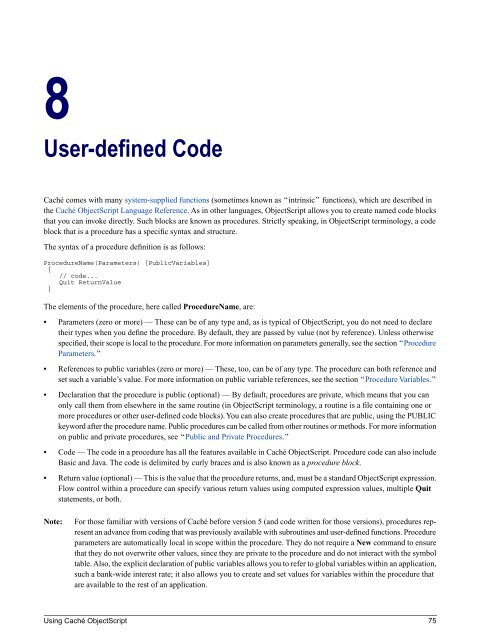Using Caché ObjectScript - InterSystems Documentation
Using Caché ObjectScript - InterSystems Documentation
Using Caché ObjectScript - InterSystems Documentation
You also want an ePaper? Increase the reach of your titles
YUMPU automatically turns print PDFs into web optimized ePapers that Google loves.
8<br />
User-defined Code<br />
<strong>Caché</strong> comes with many system-supplied functions (sometimes known as “intrinsic” functions), which are described in<br />
the <strong>Caché</strong> <strong>ObjectScript</strong> Language Reference. As in other languages, <strong>ObjectScript</strong> allows you to create named code blocks<br />
that you can invoke directly. Such blocks are known as procedures. Strictly speaking, in <strong>ObjectScript</strong> terminology, a code<br />
block that is a procedure has a specific syntax and structure.<br />
The syntax of a procedure definition is as follows:<br />
ProcedureName(Parameters) [PublicVariables]<br />
{<br />
// code...<br />
Quit ReturnValue<br />
}<br />
The elements of the procedure, here called ProcedureName, are:<br />
• Parameters (zero or more) — These can be of any type and, as is typical of <strong>ObjectScript</strong>, you do not need to declare<br />
their types when you define the procedure. By default, they are passed by value (not by reference). Unless otherwise<br />
specified, their scope is local to the procedure. For more information on parameters generally, see the section “Procedure<br />
Parameters.”<br />
• References to public variables (zero or more) — These, too, can be of any type. The procedure can both reference and<br />
set such a variable’s value. For more information on public variable references, see the section “Procedure Variables.”<br />
• Declaration that the procedure is public (optional) — By default, procedures are private, which means that you can<br />
only call them from elsewhere in the same routine (in <strong>ObjectScript</strong> terminology, a routine is a file containing one or<br />
more procedures or other user-defined code blocks). You can also create procedures that are public, using the PUBLIC<br />
keyword after the procedure name. Public procedures can be called from other routines or methods. For more information<br />
on public and private procedures, see “Public and Private Procedures.”<br />
• Code — The code in a procedure has all the features available in <strong>Caché</strong> <strong>ObjectScript</strong>. Procedure code can also include<br />
Basic and Java. The code is delimited by curly braces and is also known as a procedure block.<br />
• Return value (optional) — This is the value that the procedure returns, and, must be a standard <strong>ObjectScript</strong> expression.<br />
Flow control within a procedure can specify various return values using computed expression values, multiple Quit<br />
statements, or both.<br />
Note:<br />
For those familiar with versions of <strong>Caché</strong> before version 5 (and code written for those versions), procedures represent<br />
an advance from coding that was previously available with subroutines and user-defined functions. Procedure<br />
parameters are automatically local in scope within the procedure. They do not require a New command to ensure<br />
that they do not overwrite other values, since they are private to the procedure and do not interact with the symbol<br />
table. Also, the explicit declaration of public variables allows you to refer to global variables within an application,<br />
such a bank-wide interest rate; it also allows you to create and set values for variables within the procedure that<br />
are available to the rest of an application.<br />
<strong>Using</strong> <strong>Caché</strong> <strong>ObjectScript</strong> 75

















